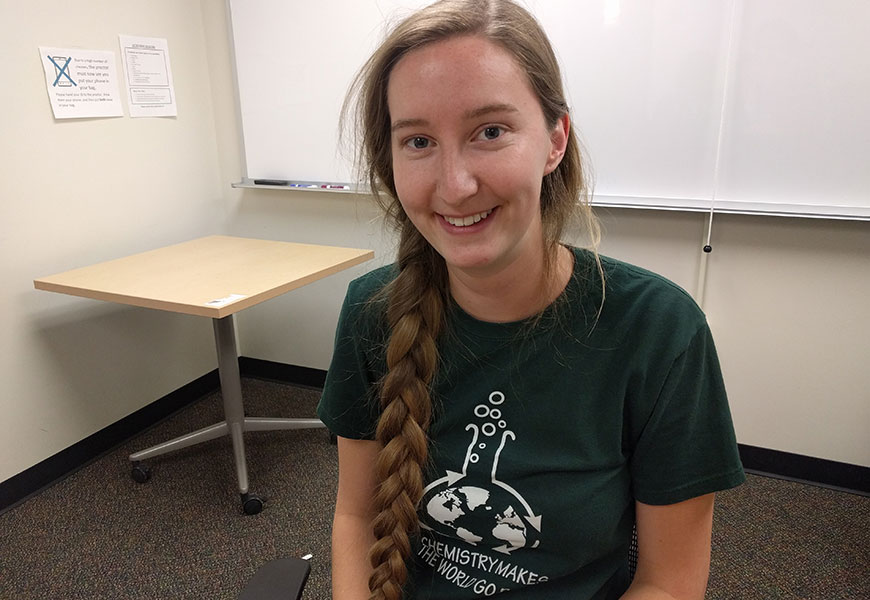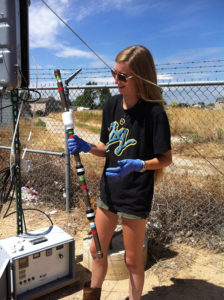Deaf student trail-blazing her way to a chemistry degree
by Anne Manning | April 14, 2017 8:25 AM

Evie Bangs may be the first deaf student to graduate with a degree in chemistry from CSU.
Evie Bangs was 5 years old when she started to lose her hearing. At age 8, her hearing plummeted, and she could no longer understand her teachers.
Now she’s about to graduate from Colorado State University. And she’s gotten here not by dwelling on what she has lost, but focusing on what she could gain – and soon, that will include a degree in chemistry from the College of Natural Sciences.
Bangs may be CSU’s first deaf chemistry major – at least in anyone’s institutional memory. It’s taken Bangs an extra year to finish her degree, in part because of the uniquely time-consuming way she must absorb challenging course material, with the help of sign language interpreters.
“When I’m in my classes, it’s kind of overwhelming,” said the Estes Park native. “I realized that in order to do well grade-wise, I needed to take fewer credits.”
Bangs has also spent that extra time working toward an American Chemical Society-certified degree, which requires additional training and lab work. Bangs aspires to attend graduate school, and become a professional chemist.
The entourage
For every class, as well as for group projects, Bangs is accompanied by two American Sign Language interpreters and one class transcriber from CSU’s Resources for Disabled Students (RDS). Her teachers joke that Bangs has an “entourage.”
The two interpreters are necessary due to the complexity of the material; sometimes, while one is working with Bangs to quickly make up signs for words like “stoichiometry” or “adiabatic process,” the other is continuing to listen to the instructor, so that Bangs misses as little as possible. Halfway through class, they switch roles. It’s called “teaming,” says RDS interpreter Dede Kliewer, and through the years of working with Bangs, everyone – including the interpreters – has learned a lot about chemistry.
Like many deaf people, Bangs can read lips, but even the best lip-readers catch 60 percent or less of what’s being said. She can get by one-on-one, but in groups or lectures, sign language and notes transcribed after the fact have been Bangs’ primary modes of learning.
RDS, part of the Division of Student Affairs, has eight sign language interpreters and 26 class transcribers, says Kliewer, who interpreted for her when Bangs was a freshman. The office also employs about 30 student notetakers. In Kliewer’s 24 years at CSU, she can’t recall another chemistry major, although they’ve had biology majors, and a chemical engineering graduate student.
Why chemistry?
It was a high school teacher who first encouraged Bangs to study chemistry in college. As a CSU freshman, Bangs enjoyed Professor Alan Van Orden’s General Chemistry for Majors course. “I remember he said on the first day, ‘Welcome to chemistry – the study of stuff!’ And I thought, ‘I don’t care how hard chemistry is going to be. I’m sticking to it!'”
Besides Van Orden, Professor Nancy Levinger was a memorable teacher for Bangs. “She helped me out a lot,” Bangs said. Levinger’s door was always open to Bangs for extra help. She took the time to write detailed lecture material on the board. And when Bangs’ interpreters were switching roles mid-class, Levinger would pause to let them catch up. “It wasn’t harming the other students, but in a way, Dr. Levinger was taking care of me,” Bangs said.
 [1]
[1]Professor Delphine Farmer’s class on environmental chemistry sparked in Bangs an interest in atmospheric research. In her junior year, Bangs became an undergraduate research assistant in the lab of Professor Jeff Collett, chair of the Department of Atmospheric Science. She’s involved in two projects now, supervised by research scientist Katie Benedict, in passive and active sampling of atmospheric ammonia all over northeastern Colorado. Recently, she co-authored a paper on the role of dew as a nighttime ammonia reservoir – her first academic publication.
Help along the way
Bangs says her family, teachers, classmates and friends have played active roles in her journey. But perhaps most of all, the RDS interpreters have helped her succeed as a student. “They were a bright spot on the bad days,” she says. “Sometimes I was not looking forward to class, but I looked forward to seeing my interpreters.”
Bangs also learned to keep lines of communication open with her professors – introducing herself at the start of the semester, and taking advantage of office hours.
“If their door was cracked, I was knocking on it,” Bangs says. She added, “Everywhere I go, here at CSU, people have filled in the gaps for me. They made it so that I could be successful.”
Between working in Collett’s lab and keeping up with classes, Bangs found time to volunteer in some of Kliewer’s American Sign Language courses. Last semester, she visited a local elementary school, where she met a fifth-grade boy whose little brother had just been born deaf. The interaction moved her to be more open about her experiences.
While being deaf sometimes requires special assistance, it is only part of a bigger story, she says.
“I’m not remarkable,” Bangs insists. “I am just like everyone else. My story is just a little different; being deaf is a tribulation that I had to get over. My cards were dealt, and others have their own challenges that they need to get over, too. Deafness, anxiety, anything at all – everyone has a story.”
Resources for Disabled Students is part of the Division of Student Affairs. It provides support for students with permanent and temporary limitations and chronic illness/health conditions, both physical and mental. Learn more[2] about the office, its staff and its services.
The Assistive Technology Resource Center, which is affiliated with Resources for Disabled Students, ensures equal access to technology and electronic information for CSU students and employees with disabilities. Learn more. [3]
- [Image]: http://source.colostate.edu/wp-content/uploads/2017/04/evie2.jpg
- Learn more: http://rds.colostate.edu/home
- Learn more. : http://atrc.colostate.edu/
Source URL: https://source.colostate.edu/deaf-student-trail-blazing-way-chemistry-degree/
Copyright ©2024 SOURCE unless otherwise noted.